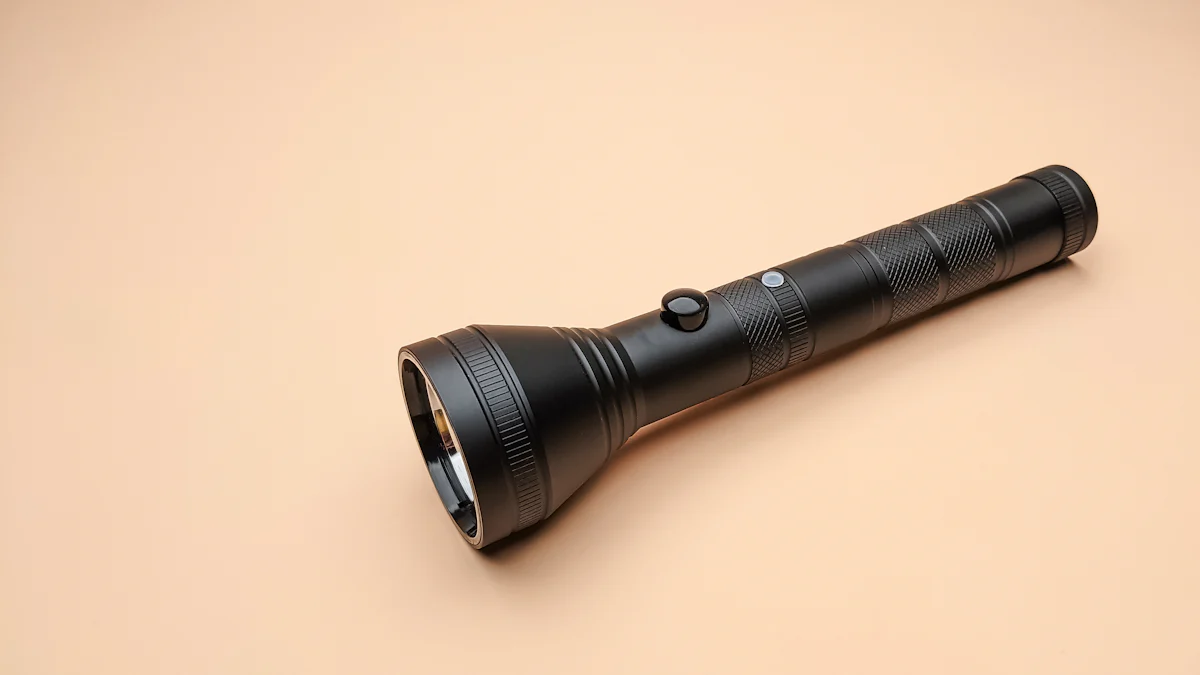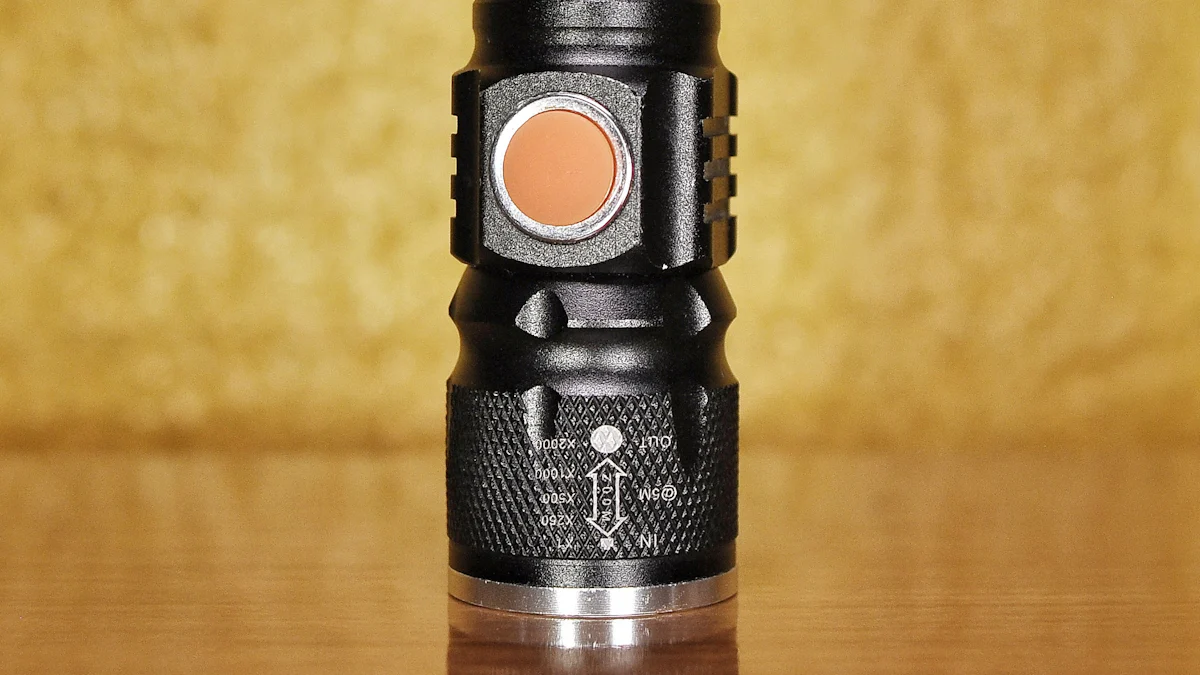Battery Flashlights vs Solar Flashlights for Emergency Prep

When preparing for an emergency, choosing the right Battery Flashlights can make a big difference. Battery-powered lights provide consistent brightness and high energy storage, making them reliable in most situations. Solar-powered lights, on the other hand, offer a sustainable option with lower long-term costs. However, they depend on sunlight and may struggle in low-light conditions. The table below highlights key factors to consider when deciding between these options:
Factor | Battery Flashlights | Solar-Powered Flashlights |
|---|---|---|
Brightness | High | Variable, depends on sunlight |
Energy Storage | High capacity | Limited capacity |
Reliability | Consistent | May struggle in low-light conditions |
Cost-effectiveness | Varies | Generally lower long-term costs |
User Experience | Familiar | Requires understanding of solar charging |
By understanding these differences, you can choose the Battery Flashlights that best suit your needs.
Key Takeaways
Battery flashlights give quick light and work well for short emergencies.
Solar flashlights use sunlight, saving money and helping the planet. They may not work well in dark places.
Having both battery and solar flashlights keeps you ready for anything.
Check and maintain both types often so they work when needed.
Look for features like water resistance and extra charging options to make your lights more reliable.
Energy Sources and Efficiency

How Battery Flashlights Work
Dependence on disposable or rechargeable batteries
Battery flashlights rely on either disposable or rechargeable batteries to function. Disposable batteries, such as AA or AAA, are widely available and easy to replace. However, they can run out quickly during extended use, leaving you searching for replacements. Rechargeable batteries offer a more sustainable option, as you can recharge them multiple times. Yet, they require access to a power source, which may not always be available during emergencies.
Availability of batteries during emergencies
In emergencies, the availability of batteries becomes a critical factor. Stockpiling disposable batteries ensures your flashlight remains operational, but this approach increases costs over time. Rechargeable batteries reduce waste and long-term expenses, but they depend on pre-charged power or a functioning grid. Without proper preparation, you might find yourself without light when you need it most.
How Solar Flashlights Work
Reliance on sunlight for charging
Solar-powered lights harness renewable energy from the sun to charge their internal batteries. This makes them an eco-friendly and cost-effective choice for emergency lights. However, their performance depends on sunlight availability. In cloudy weather or nighttime conditions, charging becomes a challenge, potentially limiting their runtime.
Built-in rechargeable batteries and backup options
Most solar flashlights come equipped with built-in rechargeable batteries, which store energy for later use. Some models also include backup charging options, such as hand cranks or USB ports, ensuring you have light even when sunlight is scarce. These features enhance their reliability, making them a versatile choice for emergencies.
Efficiency in Emergency Scenarios
Battery flashlights in prolonged power outages
Battery-powered lights excel in emergencies where immediate brightness is essential. Their high energy storage and consistent performance make them reliable during prolonged power outages. However, their runtime depends on your battery supply. Without enough replacements, their durability may fall short in extended situations.
Solar flashlights in low-sunlight conditions
Solar-powered lights shine in emergencies by offering renewable energy and reducing reliance on disposable batteries. Yet, they face limitations in low-sunlight conditions. To overcome this, many models include backup charging methods, ensuring they remain functional even when sunlight is unavailable. This adaptability makes them a dependable option for long-term preparedness.
Tip: Combining battery flashlights with solar-powered lights ensures you have reliable emergency lights for both short-term and long-term scenarios.
Cost and Maintenance
Upfront Costs
Initial price of battery-powered flashlights
Battery-powered flashlights are widely available at various price points. Basic models can cost as little as $10, while high-performance options with advanced features, such as an LED flashlight, may range from $30 to $100. These flashlights offer affordability and immediate usability, making them a popular choice for emergency lights.
Initial price of solar-powered flashlights
Solar flashlights typically have a higher upfront cost compared to battery-powered lights. Entry-level models start at around $20, while premium options with additional features, such as USB charging or hand cranks, can cost $50 or more. Despite the higher initial investment, solar flashlights provide long-term savings by eliminating the need for disposable batteries.
Long-Term Costs
Recurring cost of replacing batteries
Battery-powered lights require regular battery replacements, which can add up over time. For example:
Frequent use during emergencies increases the need for disposable batteries, leading to higher costs.
Rechargeable batteries reduce waste but still require periodic replacement.
Over five years, standard flashlights can incur approximately $800 in maintenance fees and $1,200 in energy costs.
Cost savings with solar-powered options over time
Solar flashlights eliminate energy costs entirely, as they rely on sunlight for charging. While their internal batteries may need replacement every 5-7 years, the total cost, including labor, averages around $1,000. This makes solar-powered lights a more sustainable and cost-effective option in the long run.
Maintenance Requirements
Battery storage and replacement
For battery flashlights, proper storage is essential to maintain durability. Keep spare batteries in a cool, dry place to prevent leakage. Regularly check and replace batteries to ensure your flashlight remains operational during emergencies. Rechargeable batteries require occasional charging to maintain their runtime and performance.
Care and upkeep of solar panels
To maximize the efficiency of solar flashlights, follow these maintenance practices:
Position the solar panel in direct sunlight for optimal charging.
Clean the panel regularly with a soft cloth to remove dirt and debris.
Use isopropyl alcohol for stubborn grime and compressed air for internal components.
Replace the rechargeable battery when it no longer holds a charge.
Protect the flashlight from extreme weather to extend its lifespan.
By following these steps, you can ensure your solar flashlight remains reliable for emergencies.
Note: Combining proper maintenance with strategic use of both battery and solar flashlights ensures you are prepared for any situation.
Environmental Impact

Battery Flashlights and Waste
Environmental impact of disposable batteries
Using disposable batteries in your flashlight contributes significantly to environmental harm. These batteries often end up in landfills, where they release toxic chemicals like mercury and cadmium into the soil and water. This contamination poses risks to ecosystems and human health. The frequent need to replace disposable batteries also generates a large amount of hazardous waste, making them a less sustainable option for emergency lights.
Recycling challenges for rechargeable batteries
Rechargeable batteries, while more eco-friendly than disposables, present their own challenges. Recycling these batteries is not straightforward. As Jim Puckett, executive director of Basel Action Network, explains,
“Lithium-ion batteries have not been designed for end of life.”
This lack of design foresight makes recycling difficult. Many lithium-ion batteries end up in landfills, where they contribute to ecological harm.
Lithium-ion batteries are not easy to recycle.
They often release harmful chemicals when improperly disposed of.
If you rely on rechargeable batteries for your LED flashlight, consider researching local recycling programs to minimize their environmental impact.
Solar Flashlights and Sustainability
Reduced waste with solar-powered options
Solar-powered lights offer a sustainable option by eliminating the need for disposable batteries. This reduces hazardous waste and reliance on non-renewable resources.
Solar-powered flashlights utilize renewable solar energy, which is abundant and eco-friendly.
They mitigate the environmental impact caused by the production and disposal of traditional batteries.
By choosing solar-powered lights, you can reduce your carbon footprint while ensuring reliable emergency lighting.
Longevity and eco-friendliness of solar flashlights
Solar flashlights stand out as a sustainable option due to their durability and reliance on renewable energy. These flashlights harness energy from the sun, a resource that is both renewable and free. Over time, they reduce your dependence on the grid and lower electricity expenses.
Solar-powered flashlights provide a reliable solution for off-grid or remote areas.
They minimize environmental harm by reducing the need for disposable batteries.
While the initial cost may be higher, the long-term savings and reduced waste make them a smart investment.
By maintaining your solar flashlight properly, you can extend its runtime and ensure it remains a dependable tool for emergencies.
Tip: Pairing solar-powered lights with battery flashlights gives you a balanced approach to emergency preparedness while minimizing environmental impact.
Performance and Reliability
Battery Flashlights in Emergencies
Performance during extended power outages
Battery-powered lights provide consistent illumination during emergencies, especially in prolonged power outages. Their high energy storage ensures reliable flashlight performance when immediate brightness is essential. However, their runtime depends on the availability of batteries. If you run out of replacements, the flashlight may fail when you need it most. Flashlights using AA batteries often deliver lower power output and shorter runtimes compared to models with specialized batteries. This can limit their effectiveness in emergencies requiring high-intensity light.
Dependence on battery stockpiles
Battery flashlights rely heavily on your ability to stockpile batteries. While AA batteries are widely available and easy to replace, they can add weight and bulk to your emergency kit. Advanced flashlights with features like USB recharging often require specialized batteries, which may not be as accessible during emergencies. Without proper preparation, you risk losing access to emergency lights when they are most critical.
Solar Flashlights in Emergencies
Reliability in areas with limited sunlight
Solar-powered lights excel in emergencies by utilizing renewable energy. However, their performance can decline in areas with limited sunlight, such as during overcast weather or nighttime. In these situations, charging becomes a challenge, reducing their runtime. Many solar models address this limitation by including alternative charging methods like USB ports or hand cranks. These features ensure that your flashlight remains functional even when sunlight is scarce.
Backup options for solar flashlights
Solar flashlights often come equipped with multiple charging options to enhance their reliability. USB charging allows you to recharge the flashlight using portable power banks, while hand-crank mechanisms provide an off-grid solution. These backup options ensure that solar-powered lights remain dependable during emergencies, even when the primary energy source is unavailable. This versatility makes them a practical choice for long-term preparedness.
Versatility in Different Scenarios
Urban vs. rural settings
Battery-powered lights are particularly advantageous in urban settings. AA batteries are widely available in stores, making them easy to replace during emergencies. Their affordability and compatibility with various devices add to their practicality. In rural areas, solar-powered lights may offer greater benefits. Their reliance on sunlight and renewable energy reduces the need for frequent battery replacements, making them ideal for off-grid locations.
Short-term vs. long-term emergencies
For short-term emergencies, battery-powered lights provide immediate usability and consistent brightness. However, they require regular maintenance, such as battery checks and replacements. Solar-powered lights, on the other hand, are better suited for long-term emergencies. Their reliance on renewable energy ensures they are always ready for use, reducing the need for ongoing maintenance. Combining both types of flashlights can give you a balanced approach to emergency preparedness.
Tip: Keep both a battery flashlight and a solar-powered light in your emergency kit to cover a wide range of scenarios.
Both battery flashlights and solar-powered lights offer unique benefits for emergency preparedness. Battery-powered lights provide immediate brightness and consistent performance, making them essential for short-term emergencies. Solar-powered lights, on the other hand, rely on clean energy sources like sunlight, offering a cost-effective alternative for long-term use. Their use of renewable energy reduces environmental impact and eliminates the need for frequent battery replacements.
To choose the best survival flashlight for emergencies, consider factors like runtime, durability, and versatility. Experts recommend selecting flashlights with features such as water resistance, multiple output modes, and rechargeable options. Combining battery flashlights with solar-powered lights ensures you have reliable emergency lights for any situation. This approach balances immediate usability with long-term sustainability, making it an essential addition to your survival gear.
Tip: A mix of LED battery-powered lights and solar-powered flashlights provides the best survival flashlight setup for emergencies, ensuring you’re prepared for both short-term and long-term scenarios.
FAQ
What type of flashlight is better for long-term emergencies?
Solar flashlights work best for long-term emergencies. They rely on renewable energy and reduce the need for frequent battery replacements. Their built-in rechargeable batteries and backup charging options make them a sustainable choice for extended use.
Can solar flashlights charge without direct sunlight?
Yes, solar flashlights can charge in indirect sunlight or cloudy conditions, though at a slower rate. For emergencies, choose models with backup charging options like USB ports or hand cranks to ensure reliability when sunlight is limited.
How often should you replace batteries in a flashlight?
Replace disposable batteries as soon as they run low. Rechargeable batteries typically last 2-5 years, depending on usage. Regularly check your flashlight’s performance to ensure it’s ready for emergencies.
Are solar flashlights durable in extreme weather?
Most solar flashlights are designed to withstand harsh conditions. Look for models with water resistance and rugged construction. Proper care, like cleaning the solar panel and storing it safely, extends its lifespan.
Should you keep both types of flashlights in your emergency kit?
Yes, combining battery and solar flashlights ensures you’re prepared for any situation. Battery flashlights provide immediate brightness, while solar flashlights offer long-term sustainability. This combination covers both short-term and extended emergencies.
Tip: Always test your flashlights regularly to ensure they’re functional when you need them most.
See Also
Comparing Police Flashlights and Regular Ones: Which Wins?
A Homeowner's Guide to Selecting the Ideal Emergency Flashlight
Enhance Your Camping Experience: Lanterns or Flashlights?
Why Rechargeable Flashlights Are Essential for Public Safety
Best Home Flashlights: Comparing Brightness, Durability, and Battery
